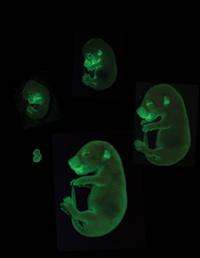New technique in RNA interference cuts time and cost in genetic screens

(Medical Xpress)—There is a new contender in the field of gene discovery, and it's giving knockout mice a run for their money. Researchers at The Rockefeller University have shown that a new technique using RNA interference is able to find genes that cause epidermal tumor growth in months rather than the decades it may take using traditional methods employing specially bred, genetically altered mice. They recently revealed the first genome-wide RNA interference screen of a mouse in an article published in Nature.
RNA interference is a natural process by which RNA molecules inhibit gene expression, but it can also be used by scientists to block a gene's function and look for those that contribute to certain diseases.
"For years, fruit flies and worms have been great model organisms because of the ability to carry out rapid genetic screens," says Elaine Fuchs, Rebecca C. Lancefield Professor. "Genetic screens in mammalian cells have been limited to petri dishes, where cells are exposed to stress and nonphysiological growth conditions."
Doing the screen involves using short pieces of RNA, called small hairpin RNAs, which are inserted into the cell and are able to halt messages from specific genes, keeping the genes from making proteins. A genetic screen might look at 15,000 genes—meaning thousands of petri dishes or fruit flies—a task deemed far too large, time-consuming and costly to do with current mouse knockout technology. But researchers led by Slobodan Beronja, a former postdoc in Fuchs's Laboratory of Mammalian Cell Biology and Development, created a special method of RNA interference, where the small hairpin RNAs are all pooled together and injected into the embryos of pregnant mice using a virus.
"We've now devised a technology where we can effectively treat the surface of living mouse embryos as a petri dish of cells, and carry out genome wide screens on mouse cells in their native environment in vivo," says Fuchs. "Previously, genome-wide screens were only possible in lower animals, such as flies, worms and yeast, where it is often difficult to assess the relevance to human disorders such as cancer."
After allowing for normal or pre-cancerous tissues to grow, the researchers quantified the number of individual small hairpin RNAs in the animals, and used it as a measure of their relative importance to the growth process, Beronja, now an assistant member at the Fred Hutchinson Cancer Research Center, explains. The result is the ability to screen more genes with fewer mice. The team screened over 16,000 genes using just 100 litters of mice, and identified about 200 genes that were uniquely important to oncogenic growth in the skin.
"We wanted to identify new genes that are worthy of creating drugs against in cancer treatment," says Beronja. "The greater the complexity of the drug treatment, the greater its success. If you attack several genes, it's more effective."
The researchers found several genes that were already known to cause tumor growth, but many, including one known as Mllt6, surprised them. Although there has been some research on it in leukemia, the gene had never been linked to solid tumors.
"The next step is to validate the list of 200-plus genes and narrow it down to the true candidates for drug therapy. Mllt6 is one that needs further exploration," says Beronja. "But we have shown that this method of genetic screening is cheaper, easier and more informative. It was a risky undertaking that Dr. Fuchs entrusted me to take, and it paid off."
More information: Beronja, S. et al. RNAi screens in mice identify physiological regulators of oncogenic growth, Nature. www.nature.com/nature/journal/ … abs/nature12464.html
















